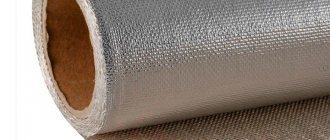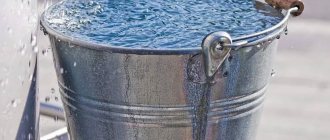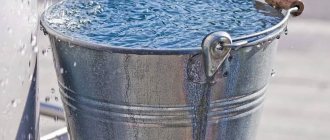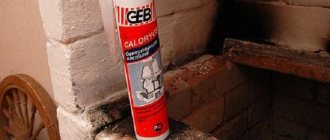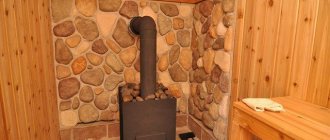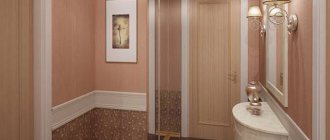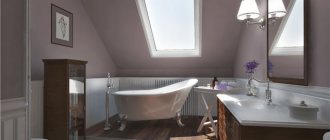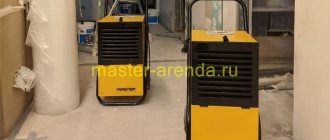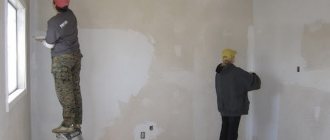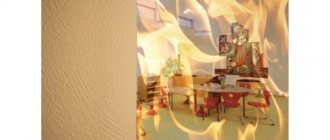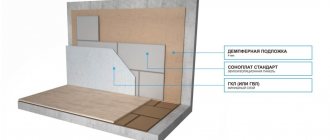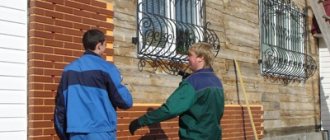Reversible screwdriver with two parts. handle, with attachments BISON PROFI 25352-H38
1033 ₽ More details
Set of screwdrivers with bits ZUBR Universal-27, in a case, 25027
1424 ₽ More details
Hammers ZUBR
When using stove heating there is a risk of fire. Most often this happens in wooden houses and bathhouses, since the surfaces located next to the heating device become very hot. To prevent disaster, you must follow the operating rules and when organizing construction, be sure to use fire-resistant materials for the walls around the stoves.
When is it necessary to create fire walls?
Fire safety requirements for the installation of stoves and fireplaces are set out in a number of GOSTs and SNiPs. They are summarized in the “Code of Rules” - SP 7.13130 “Heating, ventilation and air conditioning”, approved by Order No. 116 of 02/21/2013. by the Ministry of Emergency Situations of Russia. The requirements of the joint venture boil down to compliance with the temperatures allowed on the surfaces of the heating device and the establishment of distances between the heated surfaces of the furnaces and combustible structures. The following poster illustrates these requirements
If there is a forced reduction in the specified dimensions of fire-resistant offsets and cuts, it is necessary to use non-combustible materials for wall finishing. Considering the high decorative qualities of modern non-combustible finishing materials, their use is justified not only to prevent fires, but also in interior design projects in general.
Nuances of choice
A wide variety of species often makes you doubt the correctness of your choice. To avoid problems and to avoid regretting your decision, you need to decide on the material that will protect the walls next to the stove, chimney or fireplace.
For finishing walls around stoves and in boiler rooms
Fireproof finishing of walls around furnaces and in boiler rooms is prescribed by fire safety rules and is mandatory.
- Fire-resistant plasterboard panels can be used as a basis for cladding walls near the stove.
- Using fireclay bricks and/or mortar, create fireproof protection in the form of a screen near the furnace. The surface inside the furnace is laid out (lined) with bricks, and cracks and cracks are sealed with mortar.
- But the most effective protection for surfaces adjacent to fireplaces and stoves is made of stainless steel. Steel sheets are used to construct fireproof screens. They are mounted at a distance of 1-5 cm from the body of the stove or fireplace.
- Thermal protection can be further increased by fiberglass laid under steel sheets.
- Cast iron screens are also popular.
- Basalt rolls and mats, flexible and lightweight, are also used for shielding stoves and fireplaces.
- Terracotta or porcelain tiles are ideal for fire protection of boiler rooms, as well as baths. They do not deform or burn, and are also easy to maintain - they are easy to clean and wash. Due to their high decorative properties, they can also be used to decorate various surfaces.
For pipe
To avoid fire, chimney outlets must be reliably thermally insulated. For this purpose, mullite-silica boards and cardboard are used, which are excellent for processing. You can cut holes in them of any configuration for chimney pipes and other structural elements of stoves.
For the bath
The walls of the baths are finished with heat-resistant materials so that they have fire-resistant properties. For this use:
- “pie” made of a metal reflective coating and a heat-insulating gasket;
- superizol;
- fire-resistant plasterboard;
- glass magnesite;
- minerite;
- terracotta tiles.
Fire protection for sauna stoves is also provided by products made from foamed vermiculite. For the layer between the first rows of the stove masonry and the wooden floor, vermiculite boards are preferable, since they are stronger than cardboard.
For the fireplace
The main product used for facing the fireplace, along with fire-resistant plasterboard, is fire-resistant ceramics:
- terracotta tiles or majolica as its variety;
- tiles;
- clinker tiles;
- porcelain stoneware
All of them are moisture resistant and resistant to temperature changes. Choose tiles marked A - they are of higher quality than tiles marked B.
Scope of use
The scope of use of fire-resistant materials is somewhat wider than non-combustible materials for finishing walls under a boiler, stove or fireplace. It also includes materials used for the construction and decoration of the heating devices themselves. Refractory bricks are used for laying the internal surfaces of stoves and fireplace inserts. Fire-resistant glass inserts are tripled in stove doors and fireplace protective screens. External finishing of heating devices is not only fire-resistant plaster for the stove, but also tiles and clinker used as facing material
Minerite slabs
Cement-fiber board is used for cladding building facades. The impact-resistant plate is safe for health. Minerite - fireproof materials for walls around stoves are often used in baths and saunas. The composition of mineralite includes:
- cement;
- cellulose;
- mica;
- limestone.
Several types of fiber cement boards are produced:
- Windproof windshields are installed in façade frames.
- HD are universal products that are used for interior and facade work. They produce HD slabs of different thicknesses from 3.2 to 10 mm.
- “Pastel” slabs have a polished surface and are painted.
- The PC model is covered with façade primer and painted.
- Fire-resistant boards - for lining and protection of heating equipment.
Non-flammable sheet material is used for thermal insulation of the floor, walls, ceiling, and roof in the bathhouse. The dimensions of the mineralite sheet are: 1200x630; 1200x845; 1200x1275mm. Maximum heating up to 400 degrees. Price of sheets: 945, 1265, 1885 rubles.
Fiber cement boardsSource stroyfora.ru
Types of non-combustible wall products
Non-combustible wall products include heat-resistant plasters and mortars intended for laying heat-resistant ceramic tiles:
- terracotta;
- majolica;
- clinker tiles;
- fireclay tiles.
There are many recipes for plaster and mortar for laying ceramics.
Advice! For an amateur finishing his first stove, it is easier to purchase a ready-made mixture for plastering or laying tiles. It’s even easier, although more expensive, to entrust the matter to professionals!
An example of a fireplace with a firebox and a closed glass door. The presence of glazed doors, on the one hand, protects the interior from contamination by combustion products, and on the other, allows you to admire the fire.
Advice! Glass must be washed after each fire. Without this, they will become smoky and quickly lose transparency. This can be done with special detergent compositions for fireplace glass, or, in their absence, with powdered dishwashing detergent. The glass in the doors is tempered. Powdered detergent will not harm it.
SKL products
SCL - calcium silicate sheet - environmentally friendly material. Does not contain harmful substances and carcinogens. Retains mechanical properties - strength and hardness when heated. Contains:
- paper pulp - 10%;
- quartz powder 45%;
- cement – 40%;
- additives that increase the mechanical properties of the material – 5%.
A decorative layer with ultraviolet painting is applied to the front side of the SC sheet. The levels of fire and moisture resistance allow the use of SCL both in the external and internal decoration of buildings. This material is good for finishing rooms with high humidity - household rooms, baths, bathrooms. The ability to resist fire allows the use of SCL for finishing the walls and ceilings of rooms near the hot surfaces of the stove and fireplace.
SML products
SML - glass-magnesium sheet - is a relatively new material that has strength, flexibility, moisture and heat resistance. It includes:
- magnesium oxide – 40%;
- magnesium chloride – 35%;
- fine wood shavings – 15%;
- extruded perlite – 5%;
- additives – 4%
- fiberglass – 1%.
LSU does not have a harmful effect on the human body, therefore it is used in interior decoration. High fire resistance up to 1000°C allows it to be used as fireproof panels for interior wall decoration near heating sources and open fire.
GKLO products
GKLO is a fire-resistant plasterboard sheet. According to GOST 32614-2012, developed jointly with the Knauf company, and put into effect on the territory of the Russian Federation in 2015, this material is designated by the letter F - “fire-resistant boards”. Its fire resistance must be at least 20 minutes when exposed to open flame.
The heat resistance of gypsum plasterboard is achieved by introducing special additives into gypsum that increase the resistance of the material to high temperatures and prevent smoke from occurring in a fire. To facilitate recognition, the surface of the gypsum board is painted light pink, and the markings are done in red. Knauf Fireboard - the most fire-resistant product from Knauf - has an additional reinforcing layer of fiberglass. Used as fire-resistant cladding for walls and ceilings.
Protective screens near or around the oven
Such a system will need to be implemented when installing a potbelly stove in the corner of the room. You can mount or lay out several screens from brick, installed at a short distance from each other. In this case:
- The first screen protects a person from touching the iron stove and getting burned. It is usually made of refractory or fireclay bricks;
- To protect walls made of flammable material, a second layer of protection is provided. It can be made of brick or covered with a barrier made of sheet steel with a mirror-like front surface. In this case, heat waves will be reflected from the mirror and spread faster throughout the room;
- if the foundation is insufficient in size or it is impossible to manufacture it, it will be necessary to lay a protective screen made of durable fire-resistant material on the wooden floor. This can be a sheet of steel or a decorative layer of heat-resistant clinker tiles or porcelain stoneware. The surface will first have to be covered with a layer of thermal insulation.
Installation of metal screens
This is the easiest way to make surface protection. It is better to use sheets with a polished front surface. Before fastening, the wall surface at the required level along the height of the screen is covered with a layer of thermal insulation. In this way, we protect the surface of the walls from the effects of heat.
You can lay a layer of thermal insulation or fasten the metal with self-tapping screws with inserted ceramic spacers. But it is better to attach the screen to strips or a metal profile treated with a layer of protection. In this option, the air gap will not allow heat to pass freely to the walls, and reliable insulation of the stove from the wooden wall is ensured.
A special gap is made at the bottom of the wall for the passage of cold air, ventilation of the wall and screen. When arranging a wall with a layer of thermal insulation, a number of longitudinal guides are installed on the surface. The space between them is filled with a layer of mineral wool or other material. Then sheets of metal are installed and screwed to the sheathing with self-tapping screws.
In this design, there is no need to leave a gap at the bottom. The air will not be able to pass through calmly, but the wall will be reliably protected from high temperatures. To protect the floor of the house, a slab made of non-flammable durable material can be used.
Brick screens
This protection option is usually installed near the stove. Thus, you can protect not only the wall, but also the person from burns. By installing a brick wall, you can reduce the distance from the stove to the wall. For laying, it is better to use ceramic or fire-resistant bricks.
The work is carried out in several stages:
- you will need to make a small foundation or remove boards from the floor along the marking lines for laying the screen and, by drilling holes in the concrete of the base of the building, insert metal rods to fasten the bottom of the wall and the foundation;
- Having leveled the floor surface, lay out a layer of mortar and lay the first row of bricks; you need to place the bricks in the same plane without distortions. This determines how level your entire wall will be. Do not forget to make small grooves for ventilation; for this you can move several bricks of the bottom row.
- checking the level and pulling the twine for laying each subsequent row, all bricks are laid on a mortar of clay and sand. Having raised the wall to the required height, the top is sealed with a layer of mortar or covered with a board. This way you can make a shelf for decorative ornaments and all sorts of little things.
Fireproof ceilings
In the event of a fire, hot air and flames move upward to the ceiling of the room. Therefore, it is important to take the necessary measures in advance to ensure that a fire ceiling does not become a source of additional dangers for people caught in the fire zone. Non-combustible ceilings can be:
- Painted. Non-combustibility here depends on what material the interfloor ceiling is made of. Concrete is good! The painting was done with silicate or silicone paint - even better! Concrete does not burn. These paints also do not support combustion.
- Wallpapered. With a base on which the wallpaper is glued, as in step 1. The wallpaper itself can also be chosen as heat-resistant - based on fiberglass and metal threads.
- Tensioned. The ceiling, made of polyester impregnated with a fire-retardant compound that protects against fire, is relatively safe. Polyvinyl chloride is also considered heat-resistant, but when exposed to direct fire, it ignites and emits a large amount of gases harmful to humans. It should be used with caution.
- Plasterboard. To be considered non-flammable, such a ceiling must be made of gypsum plasterboard and painted with non-flammable paint.
- Hanging. Such ceilings are made on non-combustible metal frames made of SKL, SML or metal composite elements. The requirement of non-flammability is met.
Technology for installing fire-resistant materialheat-resistant materials for finishing walls near the stove
Multilayer protective technology, using the example of wall cladding near a heater in a bathhouse, consists of a sequence of actions:
- A layer of vapor barrier and waterproofing is attached to a wall made of combustible material. As a vapor barrier, you can use a three-layer film consisting of foil, polyethylene, and kraft paper for strength. It is attached using a metal profile (wooden blocks can be used instead of a metal profile).
- Next, insulation is installed, for example, foiled mineral wool. It is placed inside the sheathing so that the foil layer is on top. The joints of mineral wool slabs must be sealed with aluminum tape.
- Using self-tapping screws, fire-resistant boards, for example, made of fiber cement, are attached to the sheathing. An alternative to fastening a multilayer structure is to install the plates with self-tapping screws through a sleeve. This creates a space between the slab and the wall.
- After fixing the slabs, they can be faced with ceramic tiles for aesthetics. To do this, a metal mesh is screwed onto the self-tapping screws onto the slabs, onto which heat-resistant adhesive is subsequently applied and the tiles are glued.
If the installation is carried out in compliance with the technology and ventilation gaps, the wall near the stove will not heat up and will not create a fire hazard.
A budget-friendly way to protect between a stove and a wooden wall is to use profile metal used for the roof. To do this, you will need two sheets of such metal and hollow tubes. Hollow metal tubes are attached to the wall, and a metal profile is mounted to them. The distance to the floor and ceiling should be at least 10 cm. The tubes are attached to the sheet in the same place as the first ones and covered again with the sheet. Hot air moves in the gaps between the wall and the floor, while the wall remains unheated.
Source
Manufacturers and prices
When purchasing heat-resistant materials for finishing walls near the stove, it is necessary to decide the issue of choosing manufacturers and prices. It is desirable that the manufacturer of the purchased material is known, and the price is close to the generally accepted price at the time of purchase. An example of such popularity among the construction community is the Knauf company. The quality and range of products, as well as a reasonable pricing policy, allowed it to occupy 70% of the plasterboard market in the Russian Federation. Since the market situation is fluid, it makes no sense to name specific prices for materials. They depend on the region and the state of affairs in the industry. One should, however, remember the popular wisdom: “You shouldn’t chase after cheapness, priest!..”
Advice! A developer who does not want to overpay when purchasing materials should not delegate this work to a foreman. In this case, inflated prices and costs are inevitable!
Application
Fire-resistant boards are used according to the multi-layer principle. If it is necessary to perform sheathing, leave a space of 2-3 cm between the thermal insulation and the wall. The material is also glued in several layers using heat-resistant mastic.
Screens made of stainless steel sheets are most often used to insulate furnaces. This method is especially common when the stove is located too close to adjacent walls. Stainless steel sheets are often used in conjunction with non-combustible stoves. They are used as the outer surface layer. When metal sheets are polished to a shine, they tend to reflect heat. This heat flow has more gentle and gentle flows.
A protective screen made of steel is considered a ready-made structure. It goes around the entire surface of the metal stove on three sides. This is a very effective way to retain heat inside heating equipment. The external temperature with such a screen will reach approximately 100°C.
Various fireproof materials, which were mentioned in the article, are used as thermal insulation under stainless cladding. Ceramic bushings are used for fastenings. Such parts allow you to form a ventilation gap between the wall and the thermal insulation, since they do not heat up.
For wooden surfaces, such cladding will serve as reliable protection against fire and heating. In this form, the cladding will not have a beautiful appearance. To make it have a more decorative appearance, heat-resistant tiles are used. It is laid using heat-resistant glue. The best facing materials include:
- clinker tiles;
- terracotta tiles;
- porcelain stoneware;
- tiles;
- Soapstone chlorite
This type of finishing is used only as an element of a multi-layer “pie” of protection. The distance between the stove and such a surface must be at least 15-20 cm. The protective layer must have a ventilation gap and fire-resistant material. The decor will make it possible to disguise the protective layer and the finishing of the bathhouse will look in the same style.
Care Tips
In houses with stove heating, maintaining the stove and fences that protect the combustible structures of the house from overheating in good condition is the key to trouble-free living for its owners. Fire is no joke, and there are no trifles in observing fire safety rules! If they say that a sheet of metal measuring 500x700 mm is needed in front of the furnace loading door, it should be there!
Every year, before the start of the heating season, you should check the condition of the heating appliances at home. It is necessary to check whether the heat-resistant plaster of the stove is damaged, whether there are cracks in the chimney, or whether the facing tiles have fallen off. All identified defects must be corrected in a timely manner.
Fire-resistant panels are an excellent guarantee of the safety of your property.
Characteristics of stove varnish
Fireplace (or stove) varnish is most often made from silicone resin diluted in a solvent. Special additives are also added to paintwork materials. The varnish has a specific smell and transparency.
However, coloring agents can be added to paintwork materials, which will give the treated surface the desired shade.
Typically the paint composition is applied in two layers. The consumption of the substance can vary greatly, depending on the porosity of the material being processed. Each layer dries from 30 minutes to an hour at a room temperature of 18 to 25 degrees.
It is not by chance that varnish is called heat-resistant - it is able to maintain its qualities at extreme temperatures - from 200 to 250 degrees. Is it possible to varnish porcelain tiles on the floor video? There are also more thermally stable coatings, for example, aluminosilicone.
Such paints and varnishes are able to retain their qualities even at a temperature of five hundred degrees.
Choose a varnish based on your needs, consult with specialists
In addition to thermal resistance, stove varnish is characterized by other positive properties:
- resistance to high humidity and its consequences in the form of efflorescence, mold and fungi;
- protection against aggressive chemicals (solutions containing salt, petroleum products, technical oils, etc., which even after contact with the stove surface cannot be absorbed by it);
- such paintwork materials can be used not only indoors, but also outdoors;
- heat-resistant paintwork dries quickly, so you can add alkyd or acrylic varnish to it;
- high level of adhesion, which allows the composition to penetrate deeply into the material, providing it with a high level of protection;
- surfaces treated with this varnish are aesthetically pleasing to the eye, distinguished by a beautiful shine and fullness of shades.
Protective devices in the Teplodar assortment
The screen is not the only possible obstacle to hot air. A full range of measures to prevent fire due to overheating involves the use of the following materials:
The pre-furnace sheet protects the floor from sparks and combustion products.
- pre-furnace sheet (protects the floor from sparks and combustion products; located in front of the door for loading fuel);
- door with heat-resistant glass (can be installed on any Teplodar stove);
- ceiling trim (a product that encircles chimneys with a diameter of 11.5-20 cm);
- sandwich mesh (mesh chimney fencing that protects the chimney from contact with a hot surface);
- economizer (placed on the first single-wall pipe module, performs protective and decorative functions).
Metal thermal insulation is a worthy alternative to large and heavy bricks.
Teplodar products are durable, reliable, easy to maintain and have an attractive price. You can order fireproof materials for walls around stoves online on our website or by contacting us in any convenient way.
